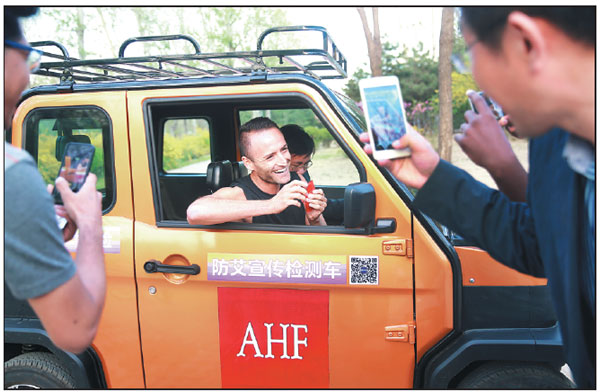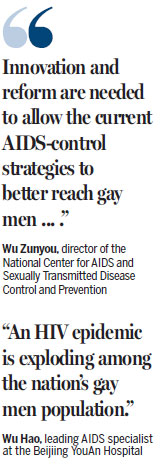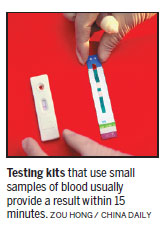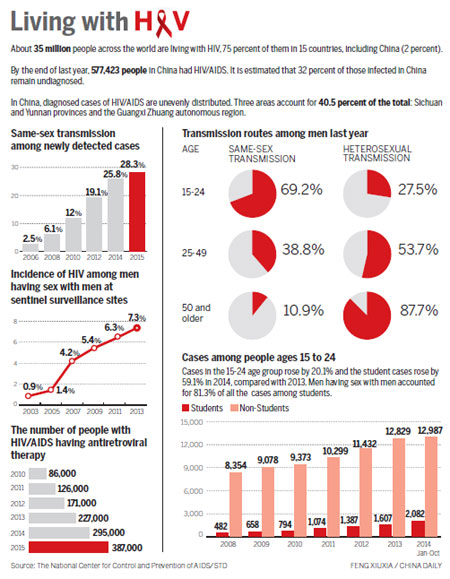
Experts say faster testing methods and earlier treatment are essential to curb an epidemic spreading among young gay men, as Shan Juan reports.
Almost every day for the past seven years, "Old" Peng has visited a hillside pavilion in Beijing's Dongdan Park.
The 60-something gay man is usually looking for a casual sexual encounter, but he also spends time listening to gay men who are struggling with their sexual orientation, and distributing condoms and tips on how to prevent becoming infected with HIV.
Although the number of young gay men visiting the park, a well-known haven for the gay community, has fallen in recent years, Peng and five fellow volunteers from the Dongcheng district disease control and prevention center still performed about 6,000 rapid HIV tests last year.
The park, 2 km east of Tian'anmen Square, has long been a popular venue for gay men from across China looking to land a date and experience a sense of belonging, according to Peng.
In recent years, an increasing number of young gay men have moved from physical meeting places to gay dating sites, and now about two-thirds of the men who regularly visit the park are middle-aged or older.
The move to the internet is one of Peng's biggest concerns: "It makes it even harder now to reach young gay men and provide AIDS intervention, but the HIV epidemic is exploding among them."
Wu Hao, a leading AIDS specialist at the Beijing YouAn Hospital at the Capital Medical University, said nearly 90 percent of HIV/AIDS cases reported in Beijing last year involved gay men. In 2013, the figure was around 70 percent.
Nationally, the incidence of HIV among gay men has soared to 8 percent from less than 1 percent in 2003, according to statistics from national sentinel surveillance sites, which measure the incidence of disease via a limited network of carefully selected sites. By contrast, the national incidence of HIV is less than 0.1 percent.
"An HIV epidemic is exploding among the nation's gay men population," Wu warned.
Higher risks
Experts estimate that China's gay men population is 25 to 30 million, but the number is not recognized by the government.
Same-sex marriage has not been legalized, which makes it hard for gay men to settle down with a partner, according to Peng. In addition, many practice anal sex, which carries a far higher risk of HIV transmission than other sexual activity.
Shang Hong, director of the HIV/AIDS key lab at the National Health and Family Planning Commission, said a survey conducted in 11 major cities last year found that the HIV prevalence rate among 8,943 men who have sex with men was 9.9 percent.
Furthermore, only 4.9 percent of men with HIV informed casual sexual partners of their positive status, and nearly 46 percent reported having unprotected sex. Intravenous drugs users are at greatest risk, she added.
Despite growing public tolerance of gay men, discrimination and social stigma still exist, and about 20 to 30 percent marry to mask their true sexual orientation, according to a 2014 study conducted by Shang's team.
Gay men in this situation are more likely to seek sex with male prostitutes, increasing their chances of contracting HIV, Shang said. "Their wives and children are at risk as well," she added, noting that many married gay men conform to social pressures by having sex to produce children, thus further increasing the chances that their partners and offspring may contract the disease.
She warned that without effective intervention, the epidemic could spread to the wider public.
Innovative approach
Wu Zunyou, director of the National Center for AIDS and Sexually Transmitted Disease Control and Prevention, echoed Shang's message: "Innovation and reform are needed to allow the current AIDS-control strategies to better reach gay men in particular for more-effective intervention."

He said gay men have long been a major target group of AIDS intervention efforts, but the epidemic has still grown quickly within the gay community.
"It's not simply down to a lack for knowledge," he added. "I used to talk with a (gay) doctor who knows all about the epidemic and the risks, but still couldn't resist having sex without a condom frequently."
Zhao, a gay man in Beijing, said the heart often overrules the head. "It's hard to always stick to protected sex - when the two of you are in the mood, you forget everything else," he said.
Because he was aware of the risks, the 35-year-old business manager at an insurance company, has had an HIV test every three months since he was 27. In January, the results came back positive.
"The day of doom finally arrived and I started antiretroviral treatment immediately," he said.
He takes three different medications every night at 11 pm, but has never revealed his HIV status to sexual partners. Gay hookup apps and websites mean casual sex is widely available, and one-night stands are even more accessible.
"It's just so easy with so many possibilities," he said.
Wu Zunyou said it's hard to change long-term behavior, even if one is fully aware of the risks. "This aspect of the 'human condition' should be introduced into intervention work targeting gay men as well."
Shang Hong, of the HIV lab, urged the mobile apps and online platforms used by gay men to provide more education to enable better-targeted intervention,
Zhao said the message must be reiterated regularly.
"At the moment, a lot of the information related to HIV is only released in the period around World AIDS Day, which falls on Dec 1 every year. For the rest of the year, I have no reliable sources of information about the prevention and treatment of HIV/AIDS. I don't know if the information available online is accurate and reliable," he said.
He warned that a lack of education can be fatal: "I have seen many young gay men die from serious complications because of late detection and treatment."

Improved outcomes
Wu Zunyou, the AIDS specialist, said there is an urgent need to detect people with the disease and provide treatment: "Early treatment improves outcomes and helps curb further HIV transmission because the viral load of the infected person is lower."
To that end, the health authorities have initiated a one-stop service, designed to facilitate quick access to lifesaving antiretroviral treatment for newly diagnosed sufferers. The process takes about two weeks from initial screening to the patient receiving medication, while it usually takes an average of two to three months, he said.
Studies in a number of pilot regions show that the project has succeeded in reducing the mortality rate from AIDS by 40 percent, thanks to more-timely treatment. "The model will be expanded nationwide within the year," Wu said.
On a visit to China earlier this month, Peter Reis, senior vice-president of the AIDS Healthcare Foundation in the United States, said he was impressed by the promising results, but the process could be accelerated by the adoption of a new approach to testing.
At present, the thousands of HIV-testing outlets in China perform rapid tests on blood samples or saliva collected via oral swabs, which can produce a result in less than 20 minutes.
However, a lab confirmation test is required before a patient is placed on a course of treatment. That can take more than a month in Beijing and even longer in remote rural areas.
"The waiting hurts mentally, and many people simply disappear from the doctors' attention during that period, mostly out of fear and uncertainty," said Xiao Dong, head of Tongzhi, an NGO committed to combating AIDS.
Reis, who spoke with Xiao during his trip, referred to an innovative approach widely practiced in the US and many other countries under which people can be put on treatment immediately if they take three rapid HIV tests and the results are all positive.
To ensure accuracy, the method employs three separate tests that are undertaken with kits made by three different manufacturers, according to Reis, whose foundation has worked closely with the Chinese health authorities for years to introduce and popularize the approach.
Wu Hao, of the YouAn hospital, a trial site partly sponsored by the foundation, said the organization has provided substantial help with the nation's new treatment strategy by providing treatment for all HIV-positive patients, regardless of their CD4 count, which indicates a person's level of immunity. A normal CD4 count ranges from 500 to 1,200 cells per square millimeter.
Previously, antiviral therapy was not administered until a patient had tested positive and had a low CD4 count, he said.
"We practiced the 'triple-rapid-test-to-treatment' model in several hundred cases and only one produced a false positive," Wu Hao said. Treatment can be given within three days as long as the patient is mentally well-prepared.
The drugs don't have serious side effects.
"In general, this method of testing method is highly accurate," he said.
Accuracy is key
Jiang Yan, head of the AIDS reference laboratory at the National Center for AIDS and Sexually Transmitted Disease Control and Prevention, said the speed and benefits of the triple-rapid-test treatment are widely recognized. "But accuracy has to be ensured as well," she said.
She said accuracy is also required from the person performing the test: "The medics at the YouAn Hospital are so well-trained that the level of accuracy is high."
She said the approach could be trialed with high-quality kits and well-trained testing staff in regions where the incidence of HIV is high and in high-risk groups, such as sexually active gay men.
The approach has been included in China's recently revised HIV testing guidelines, which will be distributed to AIDS-control agencies across the country, which is a positive move, she said.

By Shan Juan (China Daily)
Using WeChat? Scan QR Code or Press the Fingerprint Below ↓
--- (Or ADD WeChat ID: OKOKOKOKnet)
